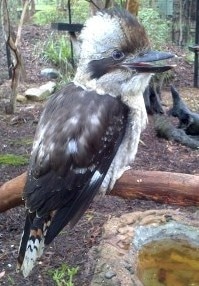-
Tasmanian Devil
Scientific Name: Sarcophilus harrisii Proudly Sponsored by Karen Murray, East Maitland, NSW Brohdi Easton, Ourimbah, NSW Sean Riley and Jess Rope, Castle Hill, NSW Annie Medlicott, Ourimbah, NSW Daniel McCallum, Fountaindale, NSW Erin Medcraft and Philip Young, Goulburn, NSW Ann Clemens, Bateman, NSW Anne Miller, Woy Woy, NSW Karen Murray, Warabrook NSW Helen Murray, East […]
Continue reading -
Eastern Grey Kangaroo
Scientific Name: Macropus giganteus Did You Know? In good seasons it is possible for female kangaroos to have three offspring at different stages. An older joey spending its time out of the pouch, a 4-5 month old mostly in the pouch and an embryo in the womb in suspended development awaiting the pouch to be […]
Continue reading -
Grey-headed Flying Fox
Scientific Name: Pteropus poliocephalus Did You Know? Mothers returning to the roost after a nights feeding are able to locate their own offspring amongst thousands of other bats simply by their individual odour. Flying foxes are not related to foxes at all but are a group of bats with fox-like heads. A familiar sight over […]
Continue reading -
Koala
Scientific Name: Phascolarctos cinereus Proudly Sponsored by Class S10 Kurrambee School, Werrington, NSW Sienna Byrne, NSW Annie, Wamberal, NSW Thomas Norman, Gosford, NSW Mackai Robinson, Ottawa, Canada Gerd, Sydney Emily Wang, Brighton Le Sands Meg and Dave Anderson, Turner, Maine, USA Jane Harris, Gosford Juniors at Wadalba, Wadalba JUNIORS AT WAMBERAL, WAMBERAL Did You Know? […]
Continue reading -
Turquoise Parrot
cientific Name: (Neophema pulchella) Did You Know? It was considered to be extinct in the wild in 1915! Over 80% of Australia’s temperate woodland (which is Turquoise Parrot habitat) has been cleared and the process is still occurring! This small parrot is about 20cm in length. It has bright green upperparts with the underparts yellow […]
Continue reading -
Laughing Kookaburra
Scientific Name: (Dacelo gigas) Proudly Sponsored by In memory of Savanah Rose Chidgey, Killarney Vale Did You Know? It has the nickname of the ‘bushman’s clock’ due to its dawn and dusk calls. The ‘laughing’ call made by this bird is actually a territorial call, warning other birds to stay away! This well-known bird is […]
Continue reading -
Banded lapwing
Scientific Name: Vanellus tricolor Did You Know? Banded lapwings usually nest in the open with little cover so that they can see danger approaching from a distance. Parents will lure threats away by pretending to be injured, often with a broken wing, and if that fails, will dive-bomb the intruder. The banded lapwing has a […]
Continue reading -
Regent honeyeater
Scientific Name: Xanthomyza phrygia Proudly Sponsored by Jamie, Leeton Did You Know? The birds have a soft metallic song and have been known to mimic other birds such as wattlebirds and friarbirds. When singing, they bob their heads. With its prettily patterned breast, the regent honeyeater is striking and distinctive. Its head is black with […]
Continue reading -
Major Mitchell cockatoo
Scientific Name: (Cacatua leadbeateri) Did You Know? During the mating season, males attract females by strutting along branches bobbing their heads with their crests raised. Adult pairs mate for life and return to the same breeding grounds year after year. Often called a pink cockatoo due to its soft pink body colouring, the Major Mitchell […]
Continue reading -
Figbird
Scientific Name: Sphecotheres viridis Did You Know? Figbirds usually nest in groups, with several nests close to each other, high up in the tree canopy. The cup shaped nests are made of vines and twigs and supported by a horizontal fork in the tree branch. These loud birds often feed in flocks of up to […]
Continue reading










